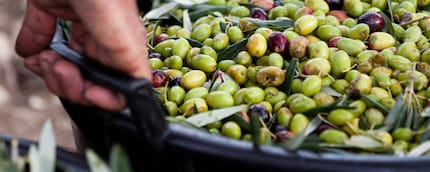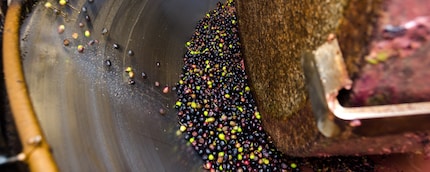

Olive oil: What does extra virgin, cold-pressed or virgin mean?
Arriving at the olive oil shelf, confusion arises: the price and labelling of olive oils are just as different as the intended uses. And what exactly do labels such as "extra virgin" or "virgin" mean? You can find out how to recognise good quality olive oil and how to find out here.
Virgin or cold-pressed olive oil can be divided into two different types. One type of extra virgin olive oil is labelled "extra", the other is not. Here are the differences
Extra virgin or virgin olive oil
Extra virgin olive oil is the purest olive juice straight from the fruit harvest. This means that only the first harvest of the year can be labelled "extra". Both production and storage are subject to a process of the highest quality, whereby no chemical products are used. Because the aim is to preserve the olive juice and its natural flavour bouquet, the juice is cold when it is pressed. This means that a maximum temperature of 27 degrees may be reached during mechanical pressing. The highest quality virgin oil is obtained using a stone mill. However, the top priority here is that hygienic conditions must be maintained. If there are still residues of older, already oxidised olive oil on the stone mill, the quality of the freshly processed olive oil is reduced. Therefore, stay away from cheap, traditionally produced oils. The acidity of this oil is a maximum of 0.8.
Virgin or virgin olive oil
Virgin olive oil without the additional designation "extra" differs from the above-mentioned oil in only a few respects. Virgin oil is produced from lower quality olives or even from subsequent harvests. Due to these changed conditions, the sensory properties are different to extra virgin oil. The acidity here is between 0.8 and 2 degrees.
Advantages of extra virgin olive oil
- Cold pressing preserves healthy, polyunsaturated fats as well as flavours and vitamins
- Typical natural flavour
Disadvantage of virgin olive oil
- Low heat stability: ingredients are lost when heat is applied
- When heated (from approx. 180 degrees), harmful substances can be produced in the worst case
Conclusion: Virgin oils should be enjoyed cold or simply to refine - but only just before serving.
Refined olive oil
Refined olive oil is a hot-pressed oil. The heat during extraction offers a significantly higher yield of the fruit. However, the oil obtained must then be refined or purified of unwanted by-products. The whole process destroys not only the highly praised vitamins but also the polyunsaturated fatty acids and flavours. This type of olive oil is almost tasteless. Small quantities of virgin olive oils are sometimes added for extra flavour. Depending on the amount of virgin oil added, the flavour can range from mild to intense. The acidity usually varies between 0.4 and 1 degree.
Advantages of refined olive oil
- Without the addition of virgin oil, it is almost flavourless
- Universally applicable
- No loss of quality at high temperatures
Disadvantage of refined olive oil
- Practically without valuable ingredients such as polyunsaturated fatty acids and vitamins

More information on olive oil labels
Organic oil
Organic oil is usually virgin. It is produced with care for the soil and the environment. Natural products are used in cultivation and production, and no chemical products such as pesticides are used. But beware; the term "organic" is not protected. Retailers who sell products as their own brand or invent their own private label have their own requirements that define a product as "organic". You are best advised to buy a product that is sold directly in the name of the producer.
Monovarietal
Monovarietal oil is made from a single variety of olive. One advantage of this oil is that it has a good and distinct flavour. Each olive variety has its own flavour - so try different monovarietal oils to find your personal favourite. Oils that come from monovarietal production are often labelled with the corresponding variety, making it easier for you to find your favourite.
Coupage
Coupage is the art of blending oils. A blend of different olive varieties is used in the production process. This allows the manufacturer to use different propositions according to the customer's wishes. This allows the flavour of the oil to be controlled and balanced in a very targeted manner.

Recognising good quality olive oil
Admittedly, you can't smell the quality when you buy it. But if you now have olive oil at home, you can check the aspects listed above and sniff the oil. If the oil smells strongly of olives, it is usually not of very high quality. Olive oils that are traditionally produced and of good quality do not have an intense olive odour. These odour notes only appear if the pressing was produced from olives that were harvested late. These olives are usually very ripe. If the harvest container is left to stand in front of the mill for a few days afterwards, the odour becomes even more intense.
The flavours you perceive should have herbal notes. Other flavours are out of place here. These can be fruity notes, such as banana or apple, or notes of grass, leaves or nuts (almonds). These notes should be appropriately fresh. In other words, if an oil has notes of grass, it should be fresh grass and not dried/wilted grass. The same applies to fruit flavours.
In addition, a good olive oil always has a spicy aftertaste reminiscent of white pepper. How intense this sharpness is varies. However, this has nothing to do with the quality; a spicier olive oil is not necessarily better than a less spicy one.
To the entire range of cooking oils
Friends, family, cats and good wine are my lifeblood.
Interesting facts about products, behind-the-scenes looks at manufacturers and deep-dives on interesting people.
Show all